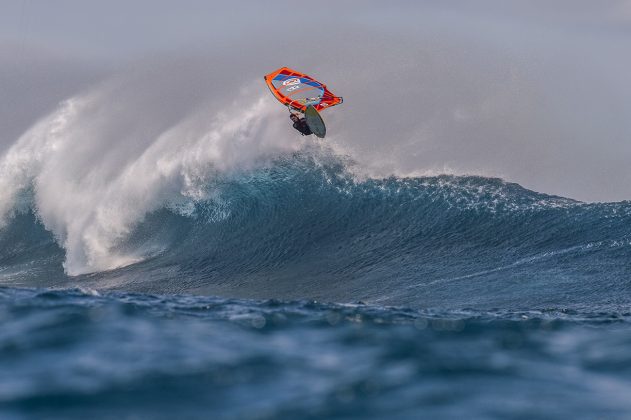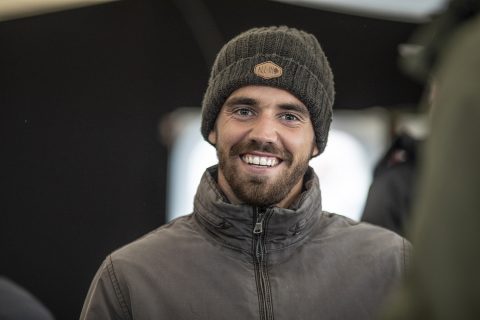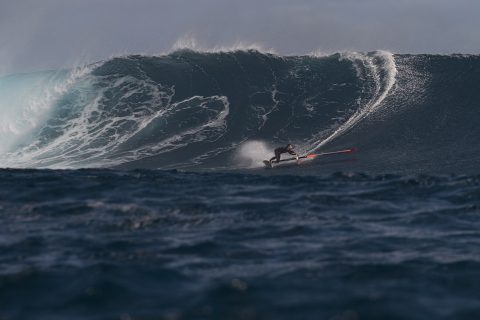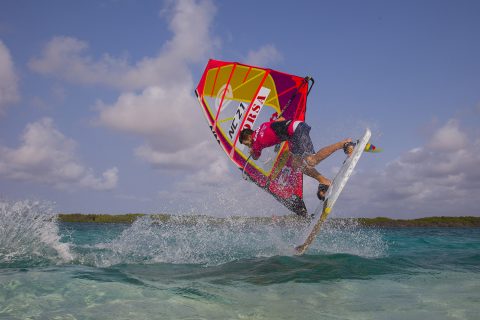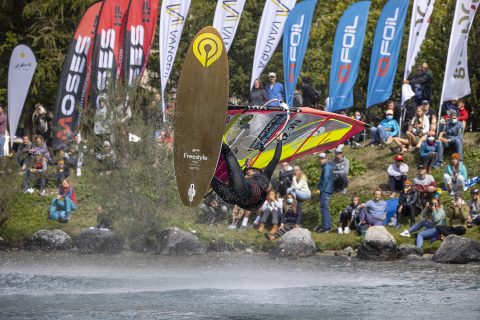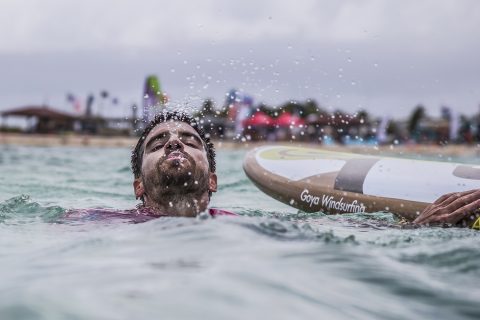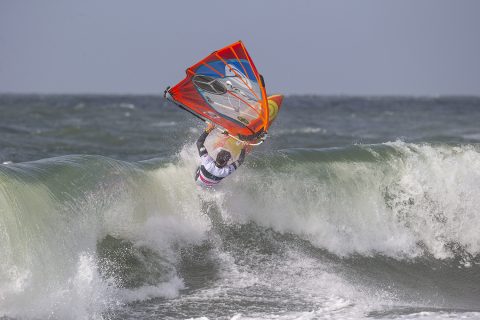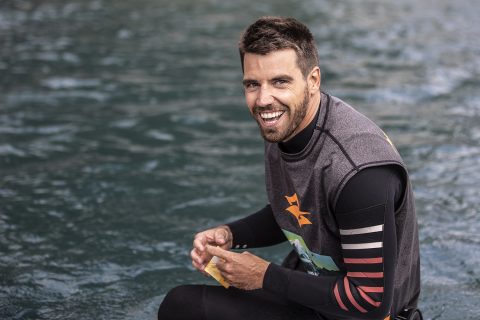From our November / December issue we featured top freestyler and wave sailor, Antoine Albert, who hails from New Caledonia. He tells us more about his home spot and why he decided to turn pro.
Words // Antoine Albert // Photos John Carter // Valérie Mouren.
ORIGINS
I was born on the 12th of April 1994 in France, but I moved to a French island situated in the Pacific Ocean called New Caledonia in early 2003 with my parents and my little brother. This is where I grew up and where I live during the off-season from competition. I lived on a boat with my family from 2005 until 2012, when I had to go to France to start my studies, like 90% of Caledonian kids.
I started windsurfing when I was 6 years old through my parents who are themselves windsurfers. I then began to train at the windsurf school of my home spot, the ACPV club in Sainte-Marie bay, Nouméa, where the 2019 PWA slalom event happened. When I was 12 years old I went to France, in Martigues, for my first French Junior Championship. It was slalom racing on Bic Techno 283 one-design gear and I managed to finish 6th in the U15 division. I was the youngest of the fleet, but I quickly get bored of racing. There was a big group of kids at our club having fun with learning tricks and pushing each other to get better, and also looking at the older generation doing loops, spocks, flakas and other old school moves. This is pretty much how I started freestyle with my father’s wave board when I was around 9. Also as a Caledonian windsurfing kid we don’t really have the ‘wave option’, as the wave spots aren’t access friendly because you need a boat to get to the reefs, so it takes usually a full day, costs a lot of money and takes a lot of energy!
- Antoine Albert
As a group we were all frothing on freestyle and it was a constant competition between us in and out of the water. We’d say stuff like, “Have you seen my move?” or “I did it first try!!” or some kind of teasing like this. We all wanted to beat our friends and were dreaming of the moves at night and then explaining our visions on land. So naturally I gravitated to freestyle competitions, it was the next logical step. All our group was motivated by the yearly Caledonian freestyle championships, we were really into it and that was my first step into official competition.
I first got into wave riding when I was 10. Upwind from the ACPV club we have a big reef system, it’s flat water in the middle of it, so you can freestyle there and then on the edge of the reef it’s wavy when it’s windy. It’s only local wind swell, straight onshore, slightly port tack jumping and tiny waves. I went to the outer reef in Ténia for the first time when I was 13 through a surf camp organized by Pierre-Yves Leroux (ex coach of Colin Sifferlen who competed on the PWA). It was super scary, but I found out that I love waves too ha ha.
SWELL TIME
A big swell of 3.8 metres and a 15 second period from the south-southwest was forecast for Saturday 6th of June 2020. It turned out to be 6 metres in the sets, with some good trade winds around 20 knots and a big low tide. The west side of New Caledonia is the best spot for these kind of conditions, where there is a little island called Ténia up north from Nouméa, the capital. To go to Ténia from Nouméa you have to drive up north with a boat and all the gear on a trailer for around an hour and fifteen, then put the boat in the water and navigate for around 30 minutes to the spot in a very choppy lagoon. On the way to the spot on Saturday, I was a bit nervous because the tide was super low with a lot of exposed reef, so if you crashed on the first part of the wave, or if you got caught inside, you would break everything and find yourself in hell, because the reef is as sharp as a knife and fully alive. The day before I had come for a warm up, as the swell was a touch smaller, but still pretty gnarly, knowing that Saturday should be bigger. When we anchored the boat there was already a few guys out. I had got a ride on the boat of my friend Yoan Despujols (a local charger) and I was the first to rig up, opting for my 4.5 Goya Banzai with my 70 litre Goya custom setup with MFC quad fins K300 13 cm / 9 cm (there’s more info. about the boards and fins I use on my YouTube channel). I went to the peak, took the first wave of a huge set, but I was a bit too deep and the wind was quite light. I tried to exit over the lip, but the gear got stuck in the wave while I flew over the top. I’d attempted to escape doing a kind of air, but was way too late, and ended up jumping over my rig out of the footstraps. I now had to deal with the second one behind, which was even bigger. I duck dived under the whitewater, but get sucked down with it. Luckily I didn’t stay too long underwater. I swam out of the spot while my friend Yoan picked me up with the boat and we went to the channel looking for my gear. By a miracle, it was all in one piece.
I kept on sailing for 4 hours after that, building confidence during the session with proper carves and a couple of airs. I was amazed by the width of the swell; sailing over them was like hiking a hill with a long curve at the top. The waves were so powerful and fast with big barrels. There was good vibes in the water, everybody was super respectful and looking after each other, it was great!!
Definitely a day to remember!!
- Freestyle action
GOYA
I’m psyched to be part of the Goya freestyle development team. I’m very lucky to be able to do that and work with legends like Francisco Goya, Keith Teboul and Jason Diffin, who are super easy to connect and work with. I benefit from their experience and knowledge from all those years working on making our sport better, more fun and more accessible. It’s so interesting for the passionate windsurfer I am. I have learnt so much about the materials, designs, shapes, manufacturing etc. and how our sport works basically. Also I’m more aware now about the feelings I like in my gear and how to attain them.
Since I joined the Goya team I have had the chance to meet Francisco Goya and he has become a really good friend since. He has such an amazing vision of life, always stoked, always smiling and having such a huge knowledge about windsurf gear and the feelings it gives. It’s so easy to develop the gear with him, sometimes I struggle to explain clearly how I feel about a board or a sail, so I just ask him to try and pay attention on, for example, putting more or less pressure on his front foot or see what the sail does on the water with more or less trim. And after just a tack he can tell me straight away, “Yeah I see, it’s because the rail is like this or the sail is like that”, I mean, he clicks in so easily it’s amazing. I remember him last year during the Goya dealer meeting in Tarifa, we were doing a wave testing day in Los Caños de Meca with proper conditions and I was sailing with my 70 litre custom wave board for reefs, set up as a thruster (10 cm / 15 cm). Francisco was curious about why I liked the board and how fun it was looking because it was kinda similar to what they were shaping for Kauli. I answered him and just asked him to try and have a couple of waves with it to also feel what the board was like. The wind was a bit light and Fran is a pretty tall guy, he was like, “Well, I don’t know, it’s a bit small for me and I’ll never be able to reach the peak with such small fins, but the board looks so fun, ok I’ll try. He went out with the board sinking to his knees, reached the peak without a problem and took the first wave, did like a sick tail blow, straight into an air and finished with a taka right on the section to close the wave out. He came back to the beach fully smiling and said, “It’s a touch small for me, I struggled with it, but it felt right like how I thought it would.” I was like, well ok, but you just destroyed that wave and everybody had their mouths open on the beach, but you say you struggled… I wish I could struggle like you too then ha ha. He’s a super fun guy!
- Freestyle action in Silvaplana
GOING PRO
When I first started the tour I was preparing for the exam to enter merchant navy school and train to be a captain. It was a tough year because it’s an entrance exam which means you have to beat the other people to gain a place on the course. I was working a lot on maths and physics, not windsurfing much compared to the guys doing it full-time. I didn’t get a place, so next I studied for a two-year degree in thermical and energies engineering before graduating with a bachelor of mechanical physics. During those five years I was not 100 per cent focussed on windsurfing, that’s why I was struggling during events. It’s hard to do both – a job / studies and sport, because both take a lot of time and energy if you want to succeed. That’s why after graduating and joining the Goya international team, I decided to be a professional windsurfer and focus only on my sport.
Now, sometimes when I’m at home, I do some private windsurf coaching, but being a professional athlete is already a full-time job with training in and out of the water, gear development and travelling, so there is not much time to do anything else. It’s a kinda strict way of life, especially with our sport depending on the weather, you can never schedule anything without the risk of missing a session. I guess in other sports you can work part of the day and practice your sport in the other part, not thinking about the forecast or whatever.
- Antoine Martin in Bonaire
COMPETITION
My first PWA experience was in Fuerteventura in 2012, I entered it thanks to Sarah-Quita a.k.a. SQ, a.k.a. the Queen of windsurfing, who convinced Annika (in charge of the event organization) to give me a wildcard. Sarah-Quita is the nicest person I have ever met, straight away we became very good friends and she even gave me one of her carbon extensions because my one was all twisted.
Arriving in the mythical Sotavento with all the top riders there was for me a living dream!! New Caledonia is really far away from the rest of the world and it’s pretty expensive to get to, so it’s super rare to have pros visit. I watch all the Kuma Movie freestyle videos and had only seen the pros before on them or other videos; I was so excited to be able to talk and windsurf with them, it was unreal.
I didn’t expect Sotavento to be so hard to sail, when you watch the videos it looks nice and flat with perfect ramps gently coming your way. The reality is that it is super choppy and the ramps are straight offshore and super close to each other. You actually need a lot of practice and experience to perform there. Also my quiver at that time was pretty small – an old 4.8 freestyle sail and a 4.0 wave sail. No 4.4, no 3.8, just one board and one boom. I didn’t manage to pass any heats, it was tough for the inexperienced kid I was! As the years passed by I learnt to be more ready, be confident, have the right gear and know what and what not to do.
Overall competition is quite stressful, especially in freestyle, as with only 2 to 3 events a year, you can’t mess any up otherwise you sink in the rankings as the level is extremely high. But I can’t complain as it’s my choice of life. If I’m bored or not happy with it, I can quit and go find myself a job.
- Sylt action
TRAINING
When I’m home, for my training out of the water I go at least five times a week to the gym. Out of those 5 times I have 3 Thai boxing sessions, one cardio workout and one functional movement session for mobility and muscle building. I stretch every day and sometimes I go to the gym to use their rollers, balls and other massage / stretching gear, this minimises my risks of injuries. I also surf a lot and do some hikes in the Caledonian mountains.
My windsurfing training in freestyle happens at the ACPV club, there are various spots around the bay where I can find dead flat water, hard choppy conditions and mellow choppy conditions etc. I try to set goals for the sessions and watch videos from other PWA freestyle riders online as I mostly sail alone at home. Otherwise I train with the boys between events at the competition spots or on other various trips.
For waves, I watch tonnes and tonnes of surfing videos and WSL heats, that inspires me a lot for how-to connect sections and do different type of turns and stuff. I also watch videos from my favourite wave riders and get inspired by their style and positioning on the wave. Then I try to recreate this on the water.
Overall I try to spend as much time on the water as possible – wave, freestyle or foil depending on the conditions.
KIT
I’m 170 cm and 65 kg. In freestyle I ride the Goya Bounce in all sizes from 3.4 up to 5.4 when the wind is extremely light and use the Goya Air 89 litre with MFC GE freestyle fin in 20 cm. For waves I ride the Goya Banzai in sizes from 3.1 to 4.5 and occasionally 5.0 during contests. For boards I mainly ride a 70-litre Goya custom, which I can set up as a quad or a thruster. It’s designed for more powerful waves, but I use it as soon as I can even in slower waves because I love the way it turns. I have a 75-litre Goya custom quad, super fast and skatey for slow mushy waves and production Goya Custom 4 Pro 68 and 74 litre for jumping. My wave fin setup is 10 cm / 15 cm MFC TF custom for the thruster (my 15 cm is narrower than the production) and MFC K300 9 cm / 13 cm for the quad. All my custom boards are 214 cm. I really love short boards as they fit better in hollow waves and also in the car ha ha.
I feel very lucky to be able to use custom wave boards shaped by Keith Teboul, specially designed for my size and style of riding. It personally helps me a lot to push my limits by being able to be quicker in the wave, having more reactivity under my feet and hit hollower parts of the wave or with more confidence.
I wish we could be allowed to use custom boards in PWA freestyle too as each rider is different in terms of size, weight and style, but we all have to be basically on the same board. Our freestyle production boards are truly amazing and work in all conditions, but sometimes I try to imagine in a perfect world being able to have this personal touch on the boards, or maybe a more specific board like the wave sailors do for certain kinds of conditions, like Sotavento for example, which is a very unique spot. Wave sailors won’t use the same board in Pozo and Cabo Verde, even if the wave production boards are working insanely good in a large range of conditions these days. The ratio between accessibility and performance is super high for production boards – super accessible but working extremely good. It’s the same for cars, but a production car is not similar in performance to the rally car Sébastien Loeb is using in competition, as he is pushing the limits of his sport as much as we do as pro windsurfers.
But the PWA and freestyle market isn’t allowing us to do customs, because of rules and the budget the brands have. Custom boards are way more expensive to build than productions and it isn’t worth it for the brand to do that. I don’t complain, I honestly love my freestyle boards, I just love to try new stuff ha ha.
- Tow surfing in Switzerland
IDOLS
As a kid my number one idol in freestyle was Kiri Thode with his super smooth and technical style doing crazy stuff in light winds that nobody else was doing. Then Kauli Seadi of course, super smooth, loose and technical in the waves but also a sick freestyler. Colin Sifferlen as well, as I grew up watching him sail. Marcilio Browne also – super explosive, fearless, and a master whatever the conditions and the spot. Those are really the styles of sailing I love.
COMPETITION
I’m competitive, that’s why I’m on the PWA and EFPT pro tours. I believe it’s a way to prove myself, show my skills and have a goal to my training and dedication. It also makes me improve faster and better because I always want to give my best during a contest.
My goal is to make a podium in the PWA and be in the top 5 overall in freestyle. I managed to reach the final four at the PWA Sylt event 2 years ago, so I’m sure I have the level. The plan is simple: train hard ha ha. Also I would love to compete in a wave event that is port tack side-off and logo to mast high on a reef break; wave riding only because that’s the type of conditions I train the most in and it would be cool to see what I could do in a contest – maybe not much ha ha.
TIPS
One time I was with a friend trying to learn how to shaka, I was maybe around 14, something like that, and was on the club’s beach, and Colin Sifferlen was there freestyling. During his break, we went up to him to ask for advice because we were struggling. He looked at us with a little smile and said super smoothly, “Shaka? Well, send it and it goes by itself.” I remember looking at my friend like, what? We do that already but it doesn’t work ha ha. He explained it to us with more details later, but it was a really funny moment and actually might be one of the best tips we got from the send it master himself!!
My best advice to other windsurfers would be to windsurf in all kinds of conditions, windy or not, because light winds are super helpful too.
LOCKDOWN
Lockdown was hard for me because I’m not the type of person who can sit at home forever if it’s windy and/or wavy, I’m too hyperactive and passionate for that. We had a 3-week lockdown with 22 confirmed cases of Covid-19 so far on the island. They closed the lagoon, meaning that you couldn’t confine yourself far away from civilization somewhere at sea, but still allowed people who were already on their boat to stay in bays accessible by roads, which is what I did with my parents. There were a lot of patrols with helicopters flying around and army boats chasing after anyone who was in the lagoon, it was scary.
- Antoine Albert on tour in Switzerland
ADDICTIVE
Windsurfing allows me to express myself, get creative and competitive. It’s also my way to have a lot of fun, travel the world and meet amazing people in the places I go to and now it’s my job. It’s super addictive and my life turns around it. As soon as there is a mini breeze, I can’t schedule anything, because there might be a chance for me to go on the water and windsurf, and I can even go in less than 13 knots now with the foil. This is why it’s so important to me and why I love it. I try to spend as much time as I can on the water.
Windsurfing has taught me how to organize myself, make decisions, and speak other languages, as well as patience, humility to nature and people, and a better control of my emotions.

